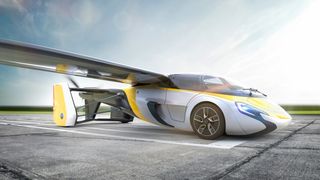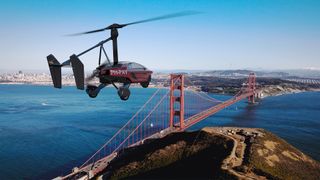Here's what flying cars will actually look like
Flying cars are coming – but they may not look quite as you expected

Main image: Airbus and Italdesign are planning to have a fleet of their Pop.Up taxis in the air by 2021. Credit: Italdesign/Airbus
"Roads? Where we're going, we don't need roads." 'Doc' Brown was right in Back to the Future. Okay, not about the time-travel thing, but the flying car thing is definitely going to happen.
Big names like Airbus, Uber, Google and Toyota all plunging big money into the development of airborne autos, and some even think we'll have flying cars in just five years.
Cars shows are already exhibiting prototypes. Long-term plans are being made by cities and transport authorities that involve flying cars. So why the heightened interest?
"There is quite a lot of hype and buzz around flying cars now, because for the first time in human history we have cutting-edge technology that can assist in building a flying car," says Joe Praveen Vijayakumar, a Mobility Industry Analyst at Frost & Sullivan, and author of a report called Future of Flying Cars, 2017–2035.
Why we need flying cars
The flying car is something born out of necessity. Forget sci-fi movies, forget travelling long distances in a flying car, and forget, well, time travel. This is about easing congestion in big cities.
"We have tried expanding the roads, built flyovers, constructed underground railway systems, and recently concepts such as ride-hailing and ride-sharing have also been popularised," says Vijayakumar, "but the menace of traffic congestion grows unabated."
Get daily insight, inspiration and deals in your inbox
Get the hottest deals available in your inbox plus news, reviews, opinion, analysis and more from the TechRadar team.
Cue a new revolution in travel by air – but crucially, this has nothing to do with airports. It's partly about re-inventing something we already have to help solve this problem – the helicopter.

Expensive, noisy, fuel-inefficient and with high emission levels, as a modern urban mobility vehicle the helicopter has no future.
"Apart from being used for sporadic urban commutes by the affluent, helicopters are rarely used for mobility purposes," adds Vijayakumar. "Clearly there is a need for an aerial vehicle that can efficiently utilise the urban airspace for future mobility. This gap could be filled by flying cars."
No wonder, then, that more than 10 companies are planning to launch a flying car by 2022.
How close are we to flying cars?
The technology to build flying cars already exists, and working prototypes are frequently appearing. Let's begin with the small, boutique automotive/aerospace companies who are getting their ideas off the ground.
The AeroMobil Flying Car swaps from electric car to plane in three minutes, does 100mph on the ground and 223mph when airborne, and has a range of about 400 miles. 500 are due to go on sale in 2020, at $1 million a throw.

However, this runway-take-off flying car, for which you would need a pilot's licence, isn't typical – or of much use for the scenario above. Don't expect a 4x4 SUV to suddenly sprout wings; the predicted future is generally about small, electric cars becoming microlight aircraft.
What’s on offer now is more intriguing than genuinely useful: there’s the PAL-V Liberty, a three-wheel car with retractable blades, which is already on sale for US$599,000, or the slightly more awkward-looking The Transition from Terrafugia, which is basically a micro-flight whose wings fold up.

However, the latter brand’s next attempt, the sleeker TF-X, looks positively awesome. Meanwhile, and oddly, the Google-backed Kitty Hawk is attracting a lot of attention despite not actually being a car.
Far more interesting is the attempt by Toyota-backed Cartivator's SkyDrive, a four-wheel, three-blade, one-seat flying car that could be even be used to fly the Olympic torch bearer to light the flame at the opening ceremony of the 2020 Tokyo Olympics.
Being used in front of the watching world would certainly give flying cars a flying start.
The first fleet?
In fact, copter-style 'flying cars' could become a reality even sooner than the end of the decade. The Dubai Road and Transportation Authority (RTA) is now conducting flight tests of vehicles, including drone-like prototypes called the Ehang 184 and the Volocopter.
It aims to launch the first fleet fleet of flying taxis by the end of this year.
"If the Dubai RTA program succeeds in launching a full scale operational fleet of flying car taxis, it could be the tipping point in encouraging other governments across the world to seriously pursue flying cars as a mainstream mode of urban mobility in the future," says Vijayakumar.

Uber is planning to test on-demand flying car taxis in Dubai by 2022, while Airbus and Italdesign are hoping to test their intriguing Pop.Up flying vehicle by the end of this year.
Designed specifically to ease congestion in megacities, Pop.Ups are modular and designed to be used as fleets of flying taxis; they separate from a base containing wheels and fly-off, with any top half able to return to and dock with any bottom half.
The tech we need to make flying cars happen
All these ideas are prototypes though, and none are likely to sell in vast numbers at first. In fact, several technologies have to converge to make flying cars mainstream, and the most important is Vertical Take Off and Landing (VTOL).
"In congested urban areas it is impossible to have separate runways or airstrips for flying cars," says Vijayakumar. "So if flying cars are to become a mainstream mode of urban mobility then it is highly imperative that they are capable of VTOL."
By now you've probably realised that most flying cars are not going to be for you to buy, but rather to sporadically rent for short journeys, most likely without a taxi driver/pilot in sight – and Vijayakumar says another key technology essential for making widespread use of flying taxis viable will be autonomous flight.

The thinking is that driverless flying cars will prevent both human error, and the malicious use of vehicles for spying (the paparazzi would otherwise have a field day following celebs and politicians).
The same tech and advantages that will power driverless cars comes into play. "Autonomous flying will also enable vehicle-to-vehicle communication and prevent two flying cars from straying into each other’s path," says Vijayakumar.
Lastly, it's clear that if electric cars are going to succeed then the automotive industry will need to develop high-capacity batteries – and that goes double for flying cars.
How would we monitor 'sky roads'?
No one is going to let you pilot a flying car. You don't have a pilot's licence. Face it: authorities don't even want you driving a car. Flying cars will be driverless, and automated, and an air traffic control system for flying cars will need to be developed.
"The Dubai RTA have announced that they will make use of their newly deployed Enterprise Command and Control Centre (EC3) to monitor the movement of autonomous flying cars in the future," explains Vijayakumar.
He thinks that the process of agreeing on regulations for flying cars will drag on far longer than that for drones, which is currently taking years.
"Comprehensive regulations for flying cars will take even more time (but) flying cars will be an integral part of smart cities of the future," he adds.
Shared mobility
Imagine the scene: you're driving along, and suddenly you get bored of the road and simply take off into the sky…
Sorry, that's not going to happen.
Largely restricted to vertical take-off, flying cars are destined to be part of primarily urban 'shared mobility services' and taxi fleets, with small, electric, automated pods transferring people between airports and city centers using a mix of road and air travel.
Simply having mature technology isn't nearly enough to make flying cars a reality. We also know that gull-wing doors aren’t going to arch upwards to become wings as your super-car heads for the high road – but this isn't even about flying cars anymore.
This is about fleets of flying robots in our cities – and we get to ride in them. Now that's proper off-roading.
This article is brought to you in association with Vodafone
- Flying cars may not be here yet, but you can still watch some of the best sci-fi movies and dream about them!
Jamie is a freelance tech, travel and space journalist based in the UK. He’s been writing regularly for Techradar since it was launched in 2008 and also writes regularly for Forbes, The Telegraph, the South China Morning Post, Sky & Telescope and the Sky At Night magazine as well as other Future titles T3, Digital Camera World, All About Space and Space.com. He also edits two of his own websites, TravGear.com and WhenIsTheNextEclipse.com that reflect his obsession with travel gear and solar eclipse travel. He is the author of A Stargazing Program For Beginners (Springer, 2015),

